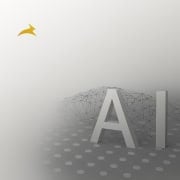Become an AI Expert in CRE: Take Google’s Generative AI Courses
Since diving into the world of commercial real estate (CRE), I’ve kept my eyes peeled for tools and technologies that can revolutionize the way we conduct business. One of the most exciting developments in recent years is artificial intelligence (AI) and its potential applications in CRE. That’s why I’m thrilled to share with you another new learning resource that’s caught my attention: Google’s Generative AI learning path.
What is Generative AI?
For those who may be unfamiliar, generative AI is a type of artificial intelligence that has the ability to create something new. It’s like giving a machine an artist’s brush, and the results can be astonishing. From creating realistic images to generating coherent text, generative AI is pushing the boundaries of what machines can do.
Below you’ll find an image I created using Midjourney, a generative AI program for generating original images from natural language descriptions. To create this image, I simply

Image created using Generative AI (Midjourney) and the prompt: a realistic, aerial view of a newly-built grocery-anchored shopping center with two quick service restaurant outparcels
Google’s Generative AI Learning Path
In line with our continued emphasis on exploring applications for AI in Commercial Real Estate (CRE), we would like to bring our readers’ attention to another remarkable resource, namely, Google’s Generative AI learning path.
Google’s Generative AI learning path comprises an expertly assembled set of courses that delve into the essentials of Large Language Models and the creation and deployment of generative AI solutions using Google Cloud. Similar to how mastering Excel or acquiring data analysis skills can distinguish job seekers, generative AI offers a unique avenue for professionals to stand out in the Commercial Real Estate (CRE) sector.
Why should CRE professionals pay attention to this technology? Imagine being able to generate accurate property descriptions, craft persuasive marketing content, or even create visual representations of future development projects—all using AI. The possibilities are vast, and the potential time and resource savings are significant.
Embrace the Impact of Artificial Intelligence in Commercial Real Estate
As of June 2023, this learning path is being offered for free from Google. While the courses themselves are generally introductory in nature, taking these courses is a fantastic opportunity to be on the front-edge of knowledge in the fast-evolving area of AI. By taking this series of free courses, you’ll gain a comprehensive understanding of Generative AI, its applications, and the tools to create and implement your own AI models.
Below find brief descriptions of the courses included in the learning path:
Introduction to Generative AI
The learning path starts with a great initial course on Generative AI. It’s all about how this type of AI can create new stuff, like text or images, and how it’s different from the usual machine learning stuff. Plus, they show off some Google Tools for creating your own Generative AI.
Introduction to Large Language Models
Next up, Google’s giving the lowdown on large language models (LLM). They explain what LLMs are, where they can be used, and how tweaking the prompts can make them perform even better. They also share how to use Google tools to develop your own LLM.
Introduction to Responsible AI
This one’s all about playing nice with AI. Google explains what responsible AI is, why it matters, and how they make sure their own AI products are playing by the rules. They even share Google’s 7 AI principles.
Generative AI Fundamentals
After you finish the first three courses, you can test your understanding of the basics of generative AI with this course. Pass the final quiz and you’ll receive a skill badge. You can then add that skill badge to your LinkedIn profile to demonstrate proficiency in generative AI.
Introduction to Image Generation
This course is all about diffusion models. These are machine learning models that take inspiration from physics, particularly thermodynamics, to generate images. They’ve been making waves in research and applications lately.
Encoder-Decoder Architecture
Here, Google breaks down the encoder-decoder architecture, a big player in tasks like machine translation and text summarization. You’ll learn about the key parts of this architecture and how they work together.
Attention Mechanism
This course shines a spotlight on the attention mechanism, a clever trick that lets neural networks focus on specific bits of an input sequence. You’ll get to understand how attention works and how it can supercharge your machine learning models.
Transformer Models and BERT Model
Next, Google introduces the Transformer architecture and the BERT model. You’ll learn about the main parts of the Transformer architecture, like the self-attention mechanism, and how it’s used to build the BERT model.
Create Image Captioning Models
This course teaches you how to teach a machine to caption images. You’ll learn about the different parts of an image captioning model and how to train and evaluate it.
Introduction to Generative AI Studio
Last but not least, Google shows off Generative AI Studio, a tool on Vertex AI for prototyping and customizing generative AI models. You’ll get to learn what it is, what it does, and how to use it.

Image created using Generative AI (Midjourney) and the prompt: female student, taking generative ai course on laptop, background university library, hyper-realistic, 4k
Have Thoughts on Generative AI?
As always, we’re keen to hear your thoughts. Have you used AI in your CRE workload? What potential uses do you see for generative AI in our industry? Feel free to reach out with thoughts or questions!
Frequently Asked Questions about Google’s Generative AI Learning Path for CRE Professionals
What is generative AI and how is it relevant to commercial real estate?
Generative AI is “a type of artificial intelligence that has the ability to create something new,” such as text, images, or code. In CRE, it can be used to generate property descriptions, draft marketing content, and visualize development projects, saving time and enhancing productivity.
What does Google’s Generative AI learning path include?
It includes several free courses, such as:
Introduction to Generative AI
Introduction to Large Language Models
Introduction to Responsible AI
Generative AI Fundamentals
Introduction to Image Generation
Encoder-Decoder Architecture
Attention Mechanism
Transformer Models and BERT
Create Image Captioning Models
Introduction to Generative AI Studio
Why should CRE professionals take these courses?
Because “generative AI offers a unique avenue for professionals to stand out” by enabling them to automate repetitive tasks, generate content, and explore new analytical tools—just as Excel and data analysis once became industry staples.
Is the learning path suitable for beginners?
Yes. The courses are described as “generally introductory in nature” and are intended to help professionals “gain a comprehensive understanding of Generative AI, its applications, and the tools to create and implement your own AI models.”
Can I earn a credential or badge from completing the courses?
Yes. After completing the Generative AI Fundamentals course and passing the final quiz, you’ll receive a skill badge that can be added to your LinkedIn profile to showcase your proficiency.
What kind of tools and technologies will I learn about?
You’ll learn about key AI concepts such as diffusion models, encoder-decoder architectures, attention mechanisms, transformer models, and tools like Generative AI Studio on Vertex AI for building and customizing your own generative AI applications.
Is the learning path still free?
As of June 2023, “this learning path is being offered for free from Google.” It provides a valuable no-cost opportunity for CRE professionals to get up to speed on cutting-edge AI tools.








